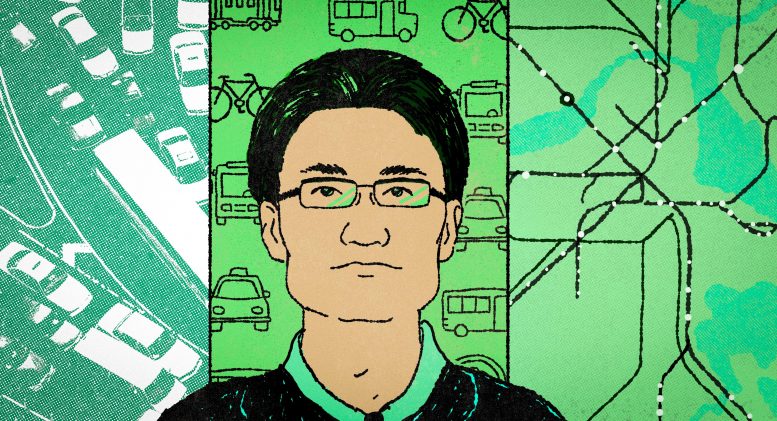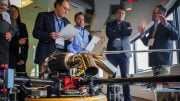
“If in the 1980s you asked people what would the [mobility] system look like 20 years in the future, they would say it would probably be the same,” Associate Professor Jinhua Zhao says. “Now, really nobody knows what it will it look like. (Image: Illustration by Jose-Luis Olivares, MIT. Based on a photo by Martin Dee.)
It’s easy to think of urban mobility strictly in terms of infrastructure: Does an area have the right rail lines, bus lanes, or bike paths? How much parking is available? How well might autonomous vehicles work? MIT Associate Professor Jinhua Zhao views matters a bit differently, however.
To understand urban movement, Zhao believes, we also need to understand people. How does everyone choose to use transport? Why do they move around, and when? How does their self-image influence their choices?
“The main part of my own thinking is the recognition that transportation systems are half physical infrastructure, and half human beings,” Zhao says.
Now, after two decades as a student and professor at MIT, he has built up an impressive body of research flowing from this approach. A bit like the best mobility systems, Zhao’s work is multimodal. He divides his scholarship into three main themes. The first covers the behavioral foundations of urban mobility: the attitudinal and emotional aspects of transportation, such as the pride people take in vehicle ownership, the experience of time spent in transit, and the decision making that results in large-scale mobility patterns within urban regions.
Zhao’s second area of scholarship applies these kinds of insights to design work, exploring how to structure mobility systems with behavioral concepts in mind. What are people’s risk preferences concerning autonomous vehicles? Will people use them in concert with existing transit? How do people’s individual characteristics affect their willingness to take ride-sharing opportunities?
Zhao’s third theme is policy-oriented: Do mobility systems provide access and fairness? Are they met with acceptance? Here Zhao’s work ranges across countries, including China, Singapore, the U.K., and the U.S., examining topics like access to rail, compliance with laws, and the public perception of transportation systems.
Within these themes, a tour of Zhao’s research reveals specific results across a wide swath of transportation issues. He has studied how multimodal smartcards affect passenger behavior (they distinctly help commuters); examined the effects of off-peak discounts on subway ridership (they reduce crowding); quantified “car pride,” the sense in which car ownership stems from social status concerns (it’s prevalent in developing countries, plus the U.S.). He has also observed how a legacy of rail transit relates to car-ownership rates even after rail lines vanish, and discovered how potential discriminatory attitudes with respect to class and race influence preferences toward ridesharing.
“People make decisions in all sorts of different ways,” Zhao says. “The notion that people wake up and calculate the utility of taking the car versus taking the bus — or walking, or cycling — and find the one that maximizes their utility doesn’t speak to reality.”
Zhao also wants to make sure that decision-makers recognize the importance of these personal factors in the overall success of their mobility systems.
“I study policy from the individual subject’s point of view,” says Zhao. “I’m a citizen. How do I think about it? Do I think this is fair? Do I understand it enough? Do I comply with the policy? It is more of a behavioral approach to policy studies.”
To be sure, Zhao is more than a researcher; he is an active mentor of MIT students, having been director of the JTL Urban Mobility Lab and the MIT Transit Lab, and chair of the Ph.D. program in the Department of Urban Studies and Planning (DUSP). And at the MIT Energy Initiative (MITEI), Zhao is also co-director of the MITEI Mobility System Center. For his research and teaching, Zhao was awarded tenure last year at MIT.
This May, Zhao added another important role to his brief: He was named director of the new MIT Mobility Initiative, an Institute-wide effort designed to cultivate a dynamic intellectual community on mobility and transportation, redefine the interdisciplinary education program, and effect fundamental changes in the long-term trajectory of mobility development in the world.
“We are at the dawn of the most profound changes in transportation: an unprecedented combination of new technologies, such as autonomy, electrification, computation and AI, and new objectives, including decarbonization, public health, economic vibrancy, data security and privacy, and social justice,” says Zhao. “The timeframe for these changes — decarbonization in particular — is short in a system with massive amounts of fixed, long-life assets and entrenched behavior and culture. It’s this combination of new technologies, new purposes, and urgent timeframes that make an MIT-led Mobility Initiative critical at this moment.”
How much can preferences be shaped?
Zhao says the current time is an “exhilarating” age for transportation scholarship. And questions surrounding the shape of mobility systems will likely only grow due to the uncertainties introduced by the ongoing COVID-19 pandemic.
“If in the 1980s you asked people what the [mobility] system would look like 20 years in the future, they would say it would probably be the same,” Zhao says. “Now, really nobody knows what it will look like.”
Zhao grew up in China and attended Tongji University in Shanghai, graduating with a bachelor’s degree in planning in 2001. He then came to MIT for his graduate studies, emerging with three degrees from DUSP: a master’s in city planning and a master’s in transportation, in 2004, and a Ph.D. in 2009.
For his doctoral dissertation, working with Joseph Ferreira of DUSP and Nigel Wilson of the Department of Civil and Environmental Engineering, Zhao examined what he calls “preference-accommodating versus preference-shaping” approaches to urban mobility.
The preference-accommodating approach, Zhao says, assumes that “people know what they want, and no one else has any right to say” what those tastes should be. But the preference-shaping approach asks, “To the degree preferences can be shaped, should they?” Tastes that we think of as almost instinctual, like the love of cars in the U.S., are much more the result of commercial influence than we usually recognize, he believes.
While that distinction was already important to Zhao when he was a student, the acceleration of climate change has made it a more urgent issue now: Can people be nudged toward a lifestyle that centers more around sustainable modes of transportation?
“People like cars today,” Zhao says. “But the auto industry spends hundreds of millions of dollars annually to construct those preferences. If every one of the 7.7 billion human beings strives to have a car as part of a successful life, no technical solutions exist today to satisfy this desire without destroying our planet.”
For Zhao, this is not an abstract discussion. A few years ago, Zhao and his colleagues Fred Salvucci, John Attanucci, and Julie Newman helped work on reforms to MIT’s own acclaimed transportation policy. Those changes fully subsidized mass transit for employees and altered campus parking fees, resulting in fewer single-occupant vehicles commuting to the Institute, reduced parking demand, and greater employee satisfaction.
Pursuing “joyful” time in the classroom
For all his research productivity, Zhao considers teaching to be at the core of his MIT responsibilities; he has received the “Committed to Caring” award from MIT’s Office of Graduate Education and considers classroom discussions to be the most energizing part of his job.
“That’s really the most joyful time I have here,” Zhao says.
Indeed, Zhao emphasizes, students are the essential fuel powering MIT’s notably interdisciplinary activities.
“I find that students are often the intermediaries that connect faculty,” Zhao says. “Most of my Ph.D. students construct a dissertation committee that, beyond me as a supervisor, has faculty from other departments. That student will get input from economists, computer scientists, and business professors. And that student brings three to four faculty together that would otherwise rarely talk to each other. I explicitly encourage students to do that, and they really enjoy it.”
His own research will always be a work in progress, Zhao says. Cities are complex, mobility systems are intricate, and the needs of people are ever-changing. So there will always be new problems for planners to study — and perhaps answer.
“Urban mobility is not something that a few brilliant researchers can work on for a year and solve,” Zhao concludes. “We have to have some degree of humility to accept its complexity.”









Be the first to comment on "What Moves People? MIT Brings Behavioral Science to Urban Transportation"